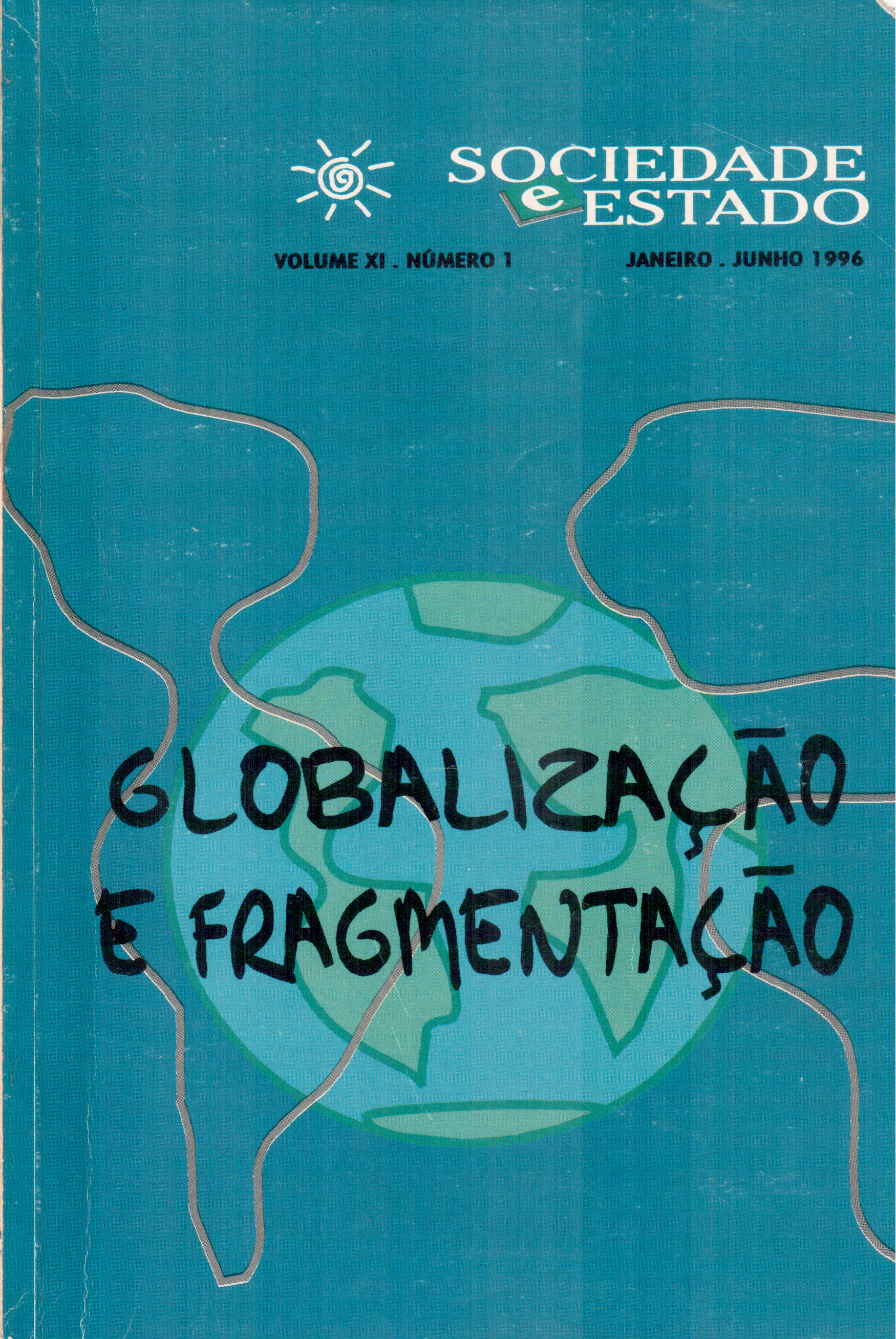LOCALISMO, GLOBALISMO E IDENTIDADE CULTURAL
Keywords:
.Abstract
This article develops a critique of simplistic and generalizing interpretations of the globalization process which emphasize either homogenization or fragmentation. The author seeks to underline the complexity of the issue, given contemporary hegemonic situation as well as preservation, adaptation and resistance strategies, employing theoretical arguments illustrated by concrete examples. The article concludes with the proposal of another model for the interpretation of the cultural globalization process, based on the social relations between established and outsider groups.
Downloads
References
Abu-Lughod, J. (1991) “Going Beyond the Global Babble”, in A. D. King (ed) Culture, Globalization and the World-system. London: Macmillan.
Anderson, B. (1991) Imagined Communities. Revised edition, London: Verso. Arensberg, C. M. (1968) The Irish Countrymen. Garden City, NY.: Natural History Press, orig. 1937.
___________and Kimball. S. T. (1940) Family and Community in Ireland. London: Peter Smith.
Appadurai, A. (1990) “Disjunction and Difference in the Global Cultural Economy,” Theory, Culture & Society , n.° 7: 2-3.
Arnason, J. (1987a) “The Modern Constellation and the Japanese Enigma,” Parti, Thesis Eleven 17.
___________ (1987b) “The Modern Constellation and the Japanese Enigma,” Part II, Thesis Eleven 18.
___________(1990) “Nationalism, Globalization and Modernity”, in Featherstone, M. (ed.) Global Culture. London: Sage.
Balibar, E. (1990) “The Nation Form: History and Ideology”, Review, 13 (3). Bauman, Z. (1991) Modernity and Ambivalence. Oxford: Polity.
Bell, C. & Newby, H. (1971) Community Studies. London: Allen and Unwin.
Bergesen, A. (1990) “Turning World-System Theory on its Head,” in M. Featherstone (ed.) Global Culture. London: Sage.
Berner, E. & Korff, R. (1992) “Strategies and Counter-Strategies: Globalization and Localization from the Perspective of the Sociology of Group Conflict,” mimeo, University of Bielefeld.
Bhabha, H. K. (1991) “Race”, Time and the Revision of Modernity,” Oxford: Literary Review, n.° 13.
Brennan, T. (1990) “The National Longing for Form,” in H. Bhabha (ed.) Nation and Narration. London: Routledge.
Bruner, E. M. (1989) “Of Cannibals, Tourists and Ethnographers,” Cultural Anthropology, 4 (4).
Burke, P. (1978) Popular Culture in Early Modern Europe. London: Temple Smith.
Canevacci, M. (1992) “Image Accumulation and Cultural Syncretism,” Theory, Culture & Society, 9 (3).
Chaney, David (1986) “The Symbolic Form of Ritual in Mass Communication,” in P. Golding (ed.) Communicating Politics. Leicester: Leicester U.P.
Cohen, A. (1985) The Symbolic Construction of Community. London: Tavistock.
Cooke, P. (1988) “Modernity, Postmodemity and the City,” Theory, Culture & Society, 5 (2-3).
____________(1990) "Locality, Structure and Agency: A Theoretical Analysis,” Cultural Anthropology, 5(1).
Critcher, C. (1979) “Sociology, Cultural Studies and the Post-war Working Class,” in J. Clarke, C. Critcher & R. Johnson (eds.), Working Class Culture. London: Hutchinson.
Dezalay, Y. (1990) “The Big Bang and the Law,” in M. Featherstone (ed.), Global Culture. London: Sage.
Dayan, D. & Katz, E. (1988) “Articulating Consensus: the Ritual and Rhetoric of Media Events,” in J. Alexander (ed.), Durkheimian Sociology: Cultural Studies. Cambridge: Cambridge U.P.
Douglas, M. & Isherwood, B. (1980) The World of Goods. Harmondsworth: Penguin.
Elias, N. (1978) The Civilizing Process, Vol. 1: the History of Manners. Oxford: Blackwell.
____________(1987) Involvement and Detachment. Oxford: Blackwell.
____________& Scotson. J. The Established and the Outsiders. Revised edition. London: Sage.
Featherstone, M. (1991) Consumer Culture and Postmodernism. London: Sage. ____________(1993) “Global and Local Cultures,” in J. Bird and G.
Robertson (eds.), Mapping the Future. London: Routledge. Reprinted in M. Featherstone Decenteing Culture: Globalization, Postmodernism and Consumption, London: Sage, 1995.
____________(1995) “The Formation of a European Culture” , in P. Dukes & M. Hepworth (ed.), Frontiers of European Culture. London: Mellon, forthcoming.
Fiske, J. Hodge, B. & Turner, G. (eds.) (1987) Myths of Oz. Sydney: Allen and Unwin.
Fjellman, S. J. (1992) Vinyl Leaves: Walt Disney World and America. Boulder: Westview Press.
Friedman, J. (1988) “Cultural Logics of Global System,” número especial sobre Pós-modernismo, Theory, Culture & Society, 5 (2-3).
___________ (1990) “Being in the World: Globalization and Localization,” in M. Featherstone (ed.), Global Culture. London: Sage.
____________(1992) “Narcissism, Roots and Postmodemity: the Constitution of Selfhood in the Global Crisis,” in S. Lash and J. Friedman (eds.), Modernity and Identity. Oxford: Blackwell.
Game, A. (1990) “Nation and Identity: Bondi”, New Formations, n.° 11. Gellner, E. (1983) Nations and Nationalism. Oxford: Blackwell.
Gessner, V. & Schade, A. (1990) “Conflicts of Culture in Gross-Border Legal
Relations,” Theory, Culture & Society, 1 (2-3).
Gupta, A. & Ferguson, J. (1992) “Beyond Culture”: Space Identity and the
Politics of Difference,” Cultural Anthropology, n.° 7: 1.
Haferkamp, H. (1987) “Beyond the Iron Cage of Modernity,” Theory, Culture & Society, n.° 4: 1.
Halbwachs, M. (1992) On Collective Memory. Chicago: Chicago University Press.
Hall, S. (1991) “Old and New Identities,” in A. King (ed.), Culture, Globalization and the World-System. London: Macmillan.
___________(1992) “The Question of Cultural Identity,” in S. Hall. D.
Held and T. McGrew (eds.), Modernity and its Futures. Oxford: Polity Press. Hannerz, U. (1990) “Cosmopolitans and Locals in World Culture,” Theory,
Culture & Society, 7 (2-3).
___________(1991) “Scenarios for Peripheral Cultures,” in A. King
(ed.), Culture, Globalization and the World-System. London: Macmillan. Higson, A. (1989) “The Concept of National Cinema,” Screen: n.° 30: 4. Hoggart, R. (1958) The Uses of Literacy. Harmondsworth: Penguin. Iyer, P. (1989) Video Nights in Kathmandu. London: Black Swan.
King, A. (1990) “Architecture, Capital and the Globalization of Culture,” in M.
Featherstone (ed.), Global Culture. London: Sage.
___________(1990b) Global Cities. London: Routledge.
------------------(1995) “The Times and Spaces of Modernity,” in M. Featherstone, S. Lash & R. Robertson (eds.), Global Modernities. London: Sage.
Kirkpatrick, John (1989) “Trials of Identity in America,” Cultural Anthropology n.° 4 (3): 301-311.
Knorr Cetina, K. (1994) “Primitive Classification and Postmodemity: Towards a Sociological Notion of Fiction”, Theory, Culture & Society, n.° 11: 3.
Laing, S. (1996) Representations of Working Class Life 1957-1964. London: Macmillan.
Ley. D. (1989) “Modernism, Post-Modernism and the Struggle for Place,” in J. A. Agnew & J. A. Duncan (eds.) The Power of Place. Boston: Unwin Hyman.
Luke, T. (1995) “New World Order or New World Orders? Power, Politics and Ideology in the Informationalizing Global Order,” in M. Featherstone, S. Lash & R. Robertson (eds.) Global Modernities. London: Sage.
Lutkehaus, N. C. (1989) “Excuse Me, Everything is Not All Right”: An
Interview with Film-maker Dennis O’Rourke, Cultural Antthropology 4 (4). MacCannell D. (1992) Empty Meeting Grounds. The Tourist Papers. London: Routledge.
Maffesoli, M. (1995) The Time of the Tribes. London: Sage.
Marcus, G. (1992) “Past, Present and Emergent Identities: Requirements for Ethnography in Late Twentieth Century Modernity”, in S. Lash and J. Friedman (eds.) Modernity and Identity. Oxford: Blackwell.
Maruyama, M. (1969) Thought and Behaviour in Japanese Politics. London: Oxford U. P.
Martin, B. (1981) A Sociology of Contemporary Cultural Change. Oxford: Blackwell.
Maybury-Lewis, D. (1992a) “On the Importance of Being Tribal,” Utney Reader, n.° 52 (July-August).
------------------(1992b) Millennium: Tribal Wisdom and the Modern World. Viking Penguin.
Meyrowitz, J. (1985) No Sense of Place. Oxford: Oxford U. P.
Middleton. D. and Edwards, D. (eds) (1990) Collective Remembering. London: Sage.
Mitsuhiro, Y. (1989) “Postmodernism and Mass Images in Japan,” Public Culture 1 (2).
Moore, S. F. (1989) “The Production of Cultural Pluralism as a Process,” Public Culture 1 (2).
Morley, D. (1991) “Where the Global Meets the Local: Notes from the Sitting Room,” Screen, 32 (1).
Moscovici, S. (1990) “Questions for the Twenty-First Century,” Theory, Culture & Society, 7 (4).
Obeyeskere, G. (1992) The Apotheosis of Captain Cook. Princeton: Princeton U. P.
Perry, C. (1986) “A Proposal to Recycle Mechanical and Organic Solidarity in Community Sociolog,” Rural Sociology, 5 (3).
Pines, J. & Willemen, P. (1989) Questions of Third Cinema. London: BFI.
Richards, J. (1984) The Age of the Dream Palace: Cinema and Society in Britain 1930-1939. London: Routledge.
Robertson, R. (1992a) “Globality and Modernity”, Theory, Culture & Society, 9(2).
____________(1992b) Globalization. London: Sage.
____________(1995) “Globalization: Time-Space and Homogeneity-Heterogeneity”, in M. Featherstone, S. Lash & R. Robertson (eds.) Global Modernities. London: Sage.
Sakai, N. (1989) “Modernity and its Critique: the Problem of Universalism and Particularism,” in H. Harootunian and M. Myoshi (eds.) Postmodernism and Japan. Durham, N. C.: Duke U. P.
Sassen, S. (1991) Global Cities: New York, London, Tokyo. Princeton: Princeton U. P.
Smith, A. D. (1990) “Towards a Global Culture?” Theory, Culture & Society, 5(2-3).
Stead, P. (1989) Film and the Working Class. London: Routledge.
Stein, M. (1960) Eclipse of Community. New York: Harper.
Theroux, P. (1992) The Happy Isles of Oceania: Paddling the Pacific. New York: Putnam.
Tomlinson, J. (1991) Cultural Imperialism. London: Pinter.
Turner, V. (1969) The Ritual Process: Structure and Anti-Structure. Har- mondsworth: Allen Lane.
Urry, J. (1990) The Tourist Gaze. London: Sage.
____________(1992) “The Tourist Gaze and the ‘Environment’”, Theory, Culture & Society, 9 (3).
Vattimo, G. (1988) The End of History. Oxford: Polity Press.
_____________(1992) The Transparent Society. Oxford: Polity Press.
Wattier, P. (1991) “The War Writings of Georg Simmel,” número especial sobre Georg Simmel, Theory, Culture & Society, 8 (3).
White, R. (1981) Inventing Australia. Sydney: Allen and Unwin.
Williams, R. (1983) Towards 2000. London: Chatto and Windus.
Williamson, B. (1982) Class, Culture and Community. London: Routledge.
Zukin, S. (1988) “The Postmodern Debate over Urban Form,” Theory, Culture & Society, 5 (2-3).
____________(1991) Landscapes of Power. From Detroit To Disney World. Berkeley: California U. P.
Downloads
Published
How to Cite
Issue
Section
License
Copyright (c) 2022 Revista Sociedade e Estado

This work is licensed under a Creative Commons Attribution-NonCommercial 4.0 International License.




.jpg)



















